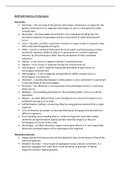Samenvatting
Summary Cell structure
- Vak
- Instelling
Summary notes for AQA A-level Biology cell structure. Includes clear information on Microscopy, cell fractionation, organelles, cell specialisation, prokaryotic cells and mitosis. Summarised from class notes and the official course textbook. From an A* student.
[Meer zien]








